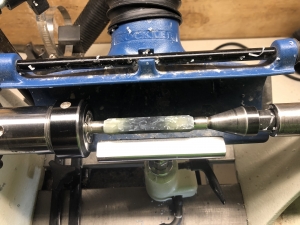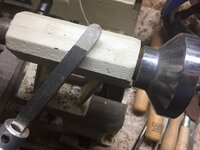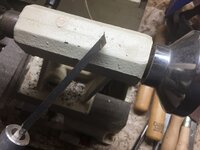I'm a HSS guy through and through, but bought a Magical Skew a few months ago specifically for turning plastic (I hate turning plastic) blanks. I had to TIG weld a new tool rest for my lathe, as neither of my other 2 would go low enough for the MS. I've used it about a dozen times, but can't for the life of me get the hang of it. It seems unless I'm SUPER careful, the thing will catch like crazy, and even when I AM super careful, it'll still catch. I've tried the round cutter, square cutter, cutting at the centerline of the work piece, cutting below the center (more like a scraper), different angles every which way, everything I can think of, and still it's a royal PITA. Then to make things worse, there's no way to make a nice even, flowing cut. You can't ride the bevel like a "real" turning tool, so it seems to me you have far less ability to get the nice, subtle curves most of us look for on a barrel. Especially with the round cutter. I can't fathom how or why anyone would use one of these things on a pen!
Now, before you say "so just go back to HSS and throw the carbide in the toolbox", here's the issue. I've got a blank I bought specifically for my mother (xmas gift) that's small sea shells encased in resin. Because the shells are so hard, I kind of need to use the carbide so I don't completely trash my go-to HSS tools. Add to that the fact that I believe it's a limited run, and the and I really can't afford a nasty catch on this one.
I just turned an acrylic pen earlier today with the MS to try and get in a bit more practice before I start on this special blank, and was barely able to finish... catch after catch, and it's almost impossible to get a nice even finish without ridges because of the shape of the cutters and the way the thing grabs the tool rest (my tool rest is ground and polished stainless steel, smoother than a baby's bottom, a chunky rest isn't the problem here!)
Does anyone have any good tips for me on how to make this work so I don't ruin this blank? I swear it was easier for me to learn to use an actual skew chisel than it has been for me to try and figure out this stupid carbide business.
Thanks in advance (my mother will thank you too!)
Now, before you say "so just go back to HSS and throw the carbide in the toolbox", here's the issue. I've got a blank I bought specifically for my mother (xmas gift) that's small sea shells encased in resin. Because the shells are so hard, I kind of need to use the carbide so I don't completely trash my go-to HSS tools. Add to that the fact that I believe it's a limited run, and the and I really can't afford a nasty catch on this one.
I just turned an acrylic pen earlier today with the MS to try and get in a bit more practice before I start on this special blank, and was barely able to finish... catch after catch, and it's almost impossible to get a nice even finish without ridges because of the shape of the cutters and the way the thing grabs the tool rest (my tool rest is ground and polished stainless steel, smoother than a baby's bottom, a chunky rest isn't the problem here!)
Does anyone have any good tips for me on how to make this work so I don't ruin this blank? I swear it was easier for me to learn to use an actual skew chisel than it has been for me to try and figure out this stupid carbide business.
Thanks in advance (my mother will thank you too!)



